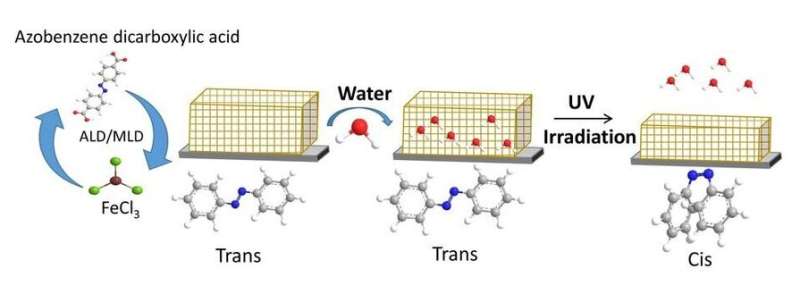A new technique for making exciting metal oxide frameworks

Metal oxide frameworks, or MOFs, are solid materials which can behave like ultra-fine sponges. The cavities in the sponge are of nanosize—about the size of individual molecules. Being made up of such suitably sized cavities or pores gives them a huge surface area to absorb and transport different molecules and chemicals, with high efficiency. This means that MOFs are attractive materials for gas storage, purifying chemicals, and drug delivery.
Researchers at Aalto University School of Chemical Engineering / Department of Chemistry and Materials Science are interested in making MOFs that can have their ability to absorb chemicals turned on and off by shining light on them. This is because shining light on something can be done without having to have contact with the MOF, and would be cheaper and more efficient than current methods that rely on temperature or pressure.
To achieve this, they have produced thin films of a MOF material that is composed of specific UV-light active organic species. These species change their molecular shape when light shines on them. On an atomic scale, MOFs are made of metal atoms linked together by organic linker molecules. The researchers at Aalto used a linker molecule that switches from being typically flat to being curved when ultraviolet light is shone on it.
The researchers have already shown that this new MOF material can be made to absorb and release gaseous water molecules on command by shining a UV light on it and the hope is that this new material they have invented can be used for advanced applications in the future.
"We believe that such control-embedded hybrid materials could open up exciting new horizons in designing novel functional nanodevices," says doctoral candidate Aida Khayyami from Aalto CHEM.
The method they have used to make the new MOF material is also of great interest, "The strongly emerging atomic/molecular layer deposition or combined ALD/MLD technique provides us with an elegant way to build such functional metal-organic materials with atomic-level control," says Professor Maarit Karppinen. "This is a new direction for the conventional ALD thin-film technology, and our research group at Aalto is one of the forerunners in this field."
The study was recently published in Angewandte Chemie.
More information: Aida Khayyami et al. Atomic/Molecular Layer Deposited Iron–Azobenzene Framework Thin Films for Stimuli‐Induced Gas Molecule Capture/Release, Angewandte Chemie (2019). DOI: 10.1002/ange.201908164
Journal information: Angewandte Chemie
Provided by Aalto University



















